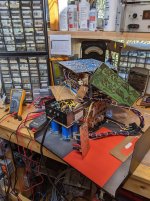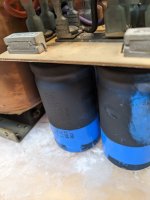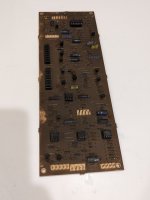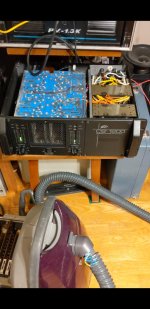I just got this unit for $100 Canadian, always wanted one! Of course the price reflects the condition! One channel was not coming on, the main 10A fuse for the DC rails was open, did some preliminary checks, rectifiers, drivers, pre drivers, outputs not shorted, nothing burned or blown up. Found the triac (SAC187) located across the speaker terminals to be shorted. Ok, replaced the triac and brought up power with a variac and 4A fuse in line with the AC supply.Check rail voltages ,78V +/- Powers up now, next check, DC offset, With both channels connected I have 4.65V DC at the speaker terminals! with one output board removed, 300mV DC, This is where i'd really like some help! I am going to start checking voltages and waveforms at the input differentials on the driver board, (at a glance I think U1A and U2A, could be wrong) I have printed the schematic out and am reviewing it now.
What's throwing me off is that the DC is present on BOTH channels, so usually you'd think there would be an issue with the power supply, which is certainly possible! But so far I havent found anything.
What say you guys? I can perform any measurements or checks, provide photos, etc, you need 🙂
Photo for entertainment value.
What's throwing me off is that the DC is present on BOTH channels, so usually you'd think there would be an issue with the power supply, which is certainly possible! But so far I havent found anything.
What say you guys? I can perform any measurements or checks, provide photos, etc, you need 🙂
Photo for entertainment value.
Attachments
One usually leaves the crowbar triac Q35 out until everything is perfect. Those that fix their own equipment leave it out permanently. It's function is to short all the output transistors if anything goes wrong. Expensive fix. Now that Michael Bean speaker disconnect is available, if you can cram two of those in the case, do so.
Look at +-15 supplies which are in common to both sides before doing anything else. I find 100 w lightbulb box would not allow my PV-1.3k to start, so I inserted a 1500 w heater element (failed tipover switch) in series with the AC input to slow down the damage while I looked for trouble. .
Look at +-15 supplies which are in common to both sides before doing anything else. I find 100 w lightbulb box would not allow my PV-1.3k to start, so I inserted a 1500 w heater element (failed tipover switch) in series with the AC input to slow down the damage while I looked for trouble. .
Well! I fixed it! I did check the +/- 15V supplies and found them to be correct. Then, confused, I thought, maybe this is a grounding issue, so I connected the DDT switch board, the input board, and chassis together at their grounds with some clip leads (the boards were loose as the unit was disaasembled for troubleshooting. Boom, DC offset gone. down to about 1mV per channel. I had a feeling it was a grounding issue, and had been checking connections elsewhere, and had wrongfully assumed that I could rely on the boards wiring for adequate grounding. I am so glad this was a relatively easy fix (all that was wrong was the shorted triac. My theory of its mode of failure is this, the unit was operating (maybe at very high ouput levels), and someone or something caused a short across that channels speaker terminals. Which somehow shorted the triac, and blew the channels rail fuse, I could be wrong here, and would love to know why the outputs didnt short, (Obviously not enough current passed to damage them).
This thing smelled absolutely horrible of some kind of cheap cologne, and smoke, I can't explain how only certain surface inside the unit, the heatsinks, and two sides of the transformers were COVERED in fine black soot. It smelled like a house fire. I took the ENTIRE unit apart, cleaned every board, the transformers, wiring harness, and scotch brited part of the power supplies steel frame, as well as the heat tunnels as well, smoke residue is hard to remove even with solvents, Washed the entire chassis with dish soap and water, dried, and reassabled, The screws were the only thing that was rusty, I can't stand rust so I used new screws.
Indianajo:
I recent;y got a 1.3k myself and found the same with using a series light bulb. what I did was install a 4A fuse in series with the AC line, and brought it up on a variac.
I love this kind of old equipment, it's heavy, built well, and reliable as long as you use the right impedance and take care of it. I really hope someone can benefit from my experience here.
This thing smelled absolutely horrible of some kind of cheap cologne, and smoke, I can't explain how only certain surface inside the unit, the heatsinks, and two sides of the transformers were COVERED in fine black soot. It smelled like a house fire. I took the ENTIRE unit apart, cleaned every board, the transformers, wiring harness, and scotch brited part of the power supplies steel frame, as well as the heat tunnels as well, smoke residue is hard to remove even with solvents, Washed the entire chassis with dish soap and water, dried, and reassabled, The screws were the only thing that was rusty, I can't stand rust so I used new screws.
Indianajo:
I recent;y got a 1.3k myself and found the same with using a series light bulb. what I did was install a 4A fuse in series with the AC line, and brought it up on a variac.
I love this kind of old equipment, it's heavy, built well, and reliable as long as you use the right impedance and take care of it. I really hope someone can benefit from my experience here.
Attachments
The harness is not pictured, but if the CS1200 uses the same punchdown block to transmit the ground from driver board to output board as the PV-1.3k, there is the fault. Punchdown block does not a 50 year connection make. Oxygen never sleeps. KKR I believe was the connector series? My unit did not have that problem but some other owner on diyaudio posted having that problem with the grounds not connecting.
The PV-1.3k had a trick to troubleshoot the driver boards. They could be reversed putting either on top.
The techs at a refrigerator factory I used to work at used a steam cleaner on the single board computers of the test equipment when they were covered in dirt. Followed by a 48 hour soak in an environmental chamber at 150 F. They would then often work normally. That factory was "cleaned" annually by blowing all the dirt on the floor & surfaces up in the air with air hoses during shutdown.
The PV-1.3k had a trick to troubleshoot the driver boards. They could be reversed putting either on top.
The techs at a refrigerator factory I used to work at used a steam cleaner on the single board computers of the test equipment when they were covered in dirt. Followed by a 48 hour soak in an environmental chamber at 150 F. They would then often work normally. That factory was "cleaned" annually by blowing all the dirt on the floor & surfaces up in the air with air hoses during shutdown.
Last edited:
So why didn’t the outputs short? They are not supposed to. These amps are supposed to survive being crowbarred by the triac if that’s all that happens. If the amplifier is operating normally and not totally out of control with shorted transistors, a short to ground on the speaker wire stays within the SOA of all those MJ15022’s. With the audio signal ground floating (which is what happened), it floated up to 4.65V. The diff amp thought that’s where zero was supposed to be and set it there. The triac fires, shorting the speaker output to ground. The VI limiters prevent output stage destruction, same as if the user had swapped 1/4” speaker plugs hot - which they do all the time.
When you get a fault due to a shorted output transistor, or a VAS stuck to the rail and the triac fires, you get massive burnout. This is because that type of fault renders the VI limiters inoperative, and the output transistors all get fried.
When you get a fault due to a shorted output transistor, or a VAS stuck to the rail and the triac fires, you get massive burnout. This is because that type of fault renders the VI limiters inoperative, and the output transistors all get fried.
I haven't heard the term VAS before, closest thing i can relate is VARs, Volt ampteres, etc, reactive power, what does VAS mean? Please forgive my ignorance. 🙂
Q11 and Q12 - the “voltage amplifier stage”. If one or the other is stuck full “on” for whatever reason there will be a huge DC offset. And since Q13 or Q14 can’t clamp it back “off”, the triac causes a totally unlimited current to flow when it fires. The first CS800 I ran into had that problem. Those has a single ended VAS, and an open current source load for it resulted in a fried triac and 10 fried output transistors.
Remove the triac. $100 in transistors burned due to a $1 fault. Two nfets series the speaker to disconnect it when DC detected is a much better design. Not available in 1985. Unfortunately you need a latch of some sort to remember there was a fault. The DC detection circuit can remain the same.The first CS800 I ran into had that problem. Those has a single ended VAS, and an open current source load for it resulted in a fried triac and 10 fried output transistors.
I think VAS means Voltage Amplifier Stage. Nobody has ever explained it.
I didn’t get it till it was already blown because of the darn triac (and MPSU60 with a fatigued leg that effing broke off - MJE350 that replaced it will never do that). I use speaker relays myself - at least at that power level. People poo poo them but they WORK. You’ve just got to use the ice cube type with the 1/4” fastons. Skycraft sold them by the bucketful for $4 a pop BACK THEN and I could always find 24V DPDTs. I even brought back a haul in 2017, which was the last time I made the pilgrimage. They still had some.
BTW - only $40 in transistors. MCM had 2SD424’s for $3.90 quantity 10+. They were a godsend. All the shops wanted $33 for ECG parts (MCM price 10.95), plus $200 labor. Which is why it ended up in my lap.
BTW - only $40 in transistors. MCM had 2SD424’s for $3.90 quantity 10+. They were a godsend. All the shops wanted $33 for ECG parts (MCM price 10.95), plus $200 labor. Which is why it ended up in my lap.
Last edited:
- Home
- Amplifiers
- Solid State
- Peavey CS-1200 amplifer, DC present on both channels





